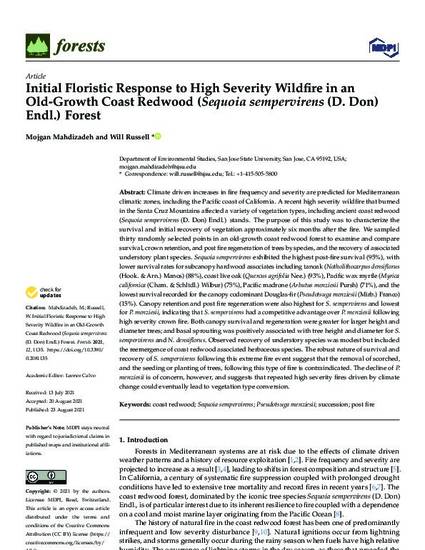
Climate driven increases in fire frequency and severity are predicted for Mediterranean climatic zones, including the Pacific coast of California. A recent high severity wildfire that burned in the Santa Cruz Mountains affected a variety of vegetation types, including ancient coast redwood (Sequoia sempervirens (D. Don) Endl.) stands. The purpose of this study was to characterize the survival and initial recovery of vegetation approximately six months after the fire. We sampled thirty randomly selected points in an old-growth coast redwood forest to examine and compare survival, crown retention, and post fire regeneration of trees by species, and the recovery of associated understory plant species. Sequoia sempervirens exhibited the highest post-fire survival (95%), with lower survival rates for subcanopy hardwood associates including tanoak (Notholithocarpus densiflorus (Hook. & Arn.) Manos) (88%), coast live oak (Quercus agrifolia Nee.) (93%), Pacific wax myrtle (Myrica californica (Cham. & Schltdl.) Wilbur) (75%), Pacific madrone (Arbutus menziesii Pursh) (71%), and the lowest survival recorded for the canopy codominant Douglas-fir (Pseudotsuga menziesii (Mirb.) Franco) (15%). Canopy retention and post fire regeneration were also highest for S. sempervirens and lowest for P. menziesii, indicating that S. sempervirens had a competitive advantage over P. menziesii following high severity crown fire. Both canopy survival and regeneration were greater for larger height and diameter trees; and basal sprouting was positively associated with tree height and diameter for S. sempervirens and N. densiflorus. Observed recovery of understory species was modest but included the reemergence of coast redwood associated herbaceous species. The robust nature of survival and recovery of S. sempervirens following this extreme fire event suggest that the removal of scorched, and the seeding or planting of trees, following this type of fire is contraindicated. The decline of P. menziesii is of concern, however, and suggests that repeated high severity fires driven by climate change could eventually lead to vegetation type conversion.
- Coast redwood,
- Post fire,
- Pseudotsuga menziesii,
- Sequoia sempervirens,
- Succession
Available at: http://works.bepress.com/will_russell/24/
